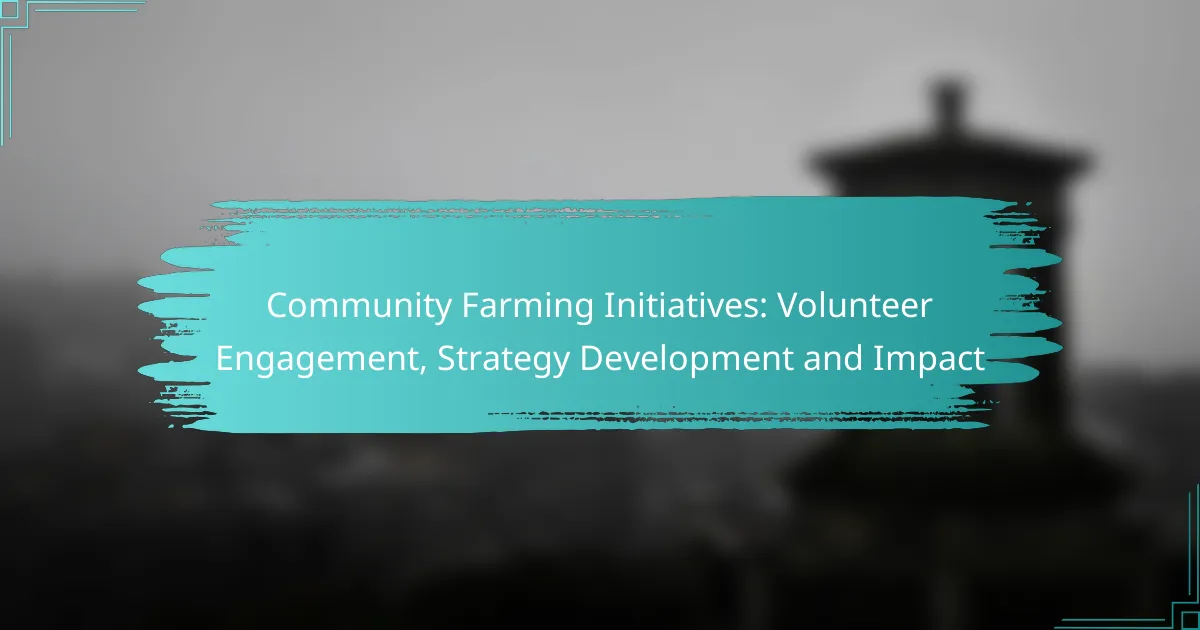Community farming initiatives play a vital role in enhancing local communities by promoting food access, environmental stewardship, and social connections. By engaging volunteers through meaningful opportunities and strategic outreach, these programs foster a sense of belonging and shared purpose. Implementing effective strategies such as clear mission statements and partnerships with local businesses can further strengthen community involvement and operational success.

How can community farming initiatives engage volunteers effectively?
Community farming initiatives can engage volunteers effectively by creating meaningful connections and providing opportunities for hands-on involvement. Strategies such as utilizing social media, organizing local events, and recognizing volunteer contributions can enhance participation and foster a sense of community.
Utilizing social media platforms
Social media platforms are powerful tools for engaging volunteers in community farming initiatives. By sharing updates, success stories, and upcoming events, organizations can attract interest and encourage participation. Platforms like Facebook, Instagram, and Twitter can help reach diverse audiences and create a vibrant online community.
To maximize engagement, consider creating dedicated groups or pages where volunteers can interact, share experiences, and ask questions. Regular posts with engaging visuals and calls to action can significantly boost volunteer involvement.
Organizing local events
Local events are essential for fostering community spirit and attracting volunteers to farming initiatives. Hosting activities such as planting days, harvest festivals, or educational workshops allows individuals to connect with the cause and each other. These events can also serve as platforms for showcasing the benefits of community farming.
When organizing events, ensure they are accessible and inclusive, catering to various age groups and skill levels. Promote these events through local channels and social media to maximize attendance and engagement.
Creating volunteer recognition programs
Recognizing volunteers’ contributions is crucial for maintaining motivation and commitment. Implementing a recognition program can include awards, certificates, or public acknowledgments during events. This not only appreciates volunteers but also encourages others to get involved.
Consider establishing a tiered recognition system where volunteers can achieve different levels based on their involvement. This approach can foster a sense of achievement and community pride among participants.
Partnering with schools and universities
Collaborating with schools and universities can significantly enhance volunteer engagement in community farming. Educational institutions often seek practical experiences for students, making them ideal partners for farming initiatives. Involving students can bring fresh energy and innovative ideas to projects.
To establish partnerships, reach out to local schools and universities to propose joint projects or internships. This collaboration can benefit both parties, providing students with hands-on learning opportunities while boosting volunteer numbers for the farming initiative.
Offering skill-building workshops
Skill-building workshops are an effective way to engage volunteers by providing them with valuable knowledge and hands-on experience. Workshops can cover various topics, such as organic farming techniques, pest management, or sustainable practices, catering to different skill levels.
When planning workshops, ensure they are interactive and practical, allowing participants to apply what they learn. Offering these workshops for free or at a low cost can attract a wider audience and encourage ongoing volunteer involvement in community farming initiatives.

What strategies enhance community farming initiatives?
Effective strategies for enhancing community farming initiatives include establishing clear mission statements, implementing sustainable practices, and fostering partnerships with local businesses. These approaches not only improve operational efficiency but also strengthen community engagement and support.
Developing clear mission statements
A clear mission statement articulates the purpose and goals of a community farming initiative, guiding its activities and decisions. It should reflect the community’s values and the specific outcomes the initiative aims to achieve, such as promoting local food security or environmental sustainability.
When crafting a mission statement, involve community members to ensure it resonates with their needs and aspirations. A well-defined mission can help attract volunteers and donors who share similar values, enhancing overall engagement.
Implementing sustainable practices
Sustainable practices are crucial for the long-term viability of community farming initiatives. This includes using organic farming methods, conserving water, and minimizing waste through composting and recycling. Implementing these practices not only benefits the environment but also attracts community members who prioritize sustainability.
Consider adopting permaculture principles or crop rotation strategies to maintain soil health and biodiversity. Regular workshops can educate volunteers about these practices, fostering a culture of sustainability within the community.
Building partnerships with local businesses
Forming partnerships with local businesses can provide essential resources and support for community farming initiatives. These partnerships can include sponsorships, donations of materials, or collaborative events that promote local produce.
Engaging local restaurants, grocery stores, and farmers’ markets can create a mutually beneficial relationship, where businesses gain access to fresh produce while supporting community efforts. This collaboration can also enhance visibility and attract more volunteers.
Creating a community advisory board
A community advisory board can provide valuable insights and guidance for farming initiatives. Composed of diverse community members, this board can help identify local needs, suggest improvements, and foster greater community involvement.
Regular meetings can facilitate open communication and ensure that the initiative remains aligned with community interests. This inclusive approach can also enhance transparency and trust among stakeholders.
Utilizing grant funding opportunities
Securing grant funding can significantly bolster community farming initiatives by providing financial resources for projects and operational costs. Research local, state, and federal grant opportunities that support agricultural development, sustainability, and community engagement.
When applying for grants, clearly outline the initiative’s goals, expected outcomes, and community benefits. Collaborating with local organizations can strengthen applications and increase the chances of securing funding. Be mindful of deadlines and specific requirements for each grant to maximize opportunities.

What impact do community farming initiatives have on local communities?
Community farming initiatives significantly enhance local communities by improving food access, fostering social connections, and promoting environmental stewardship. These programs not only provide fresh produce but also create a sense of belonging and shared purpose among participants.
Improved food security
Community farming initiatives directly contribute to improved food security by increasing the availability of fresh, locally grown produce. This is especially vital in urban areas where access to healthy food options can be limited.
By engaging local residents in farming activities, these initiatives help ensure that families have reliable access to nutritious food, reducing dependency on distant supply chains and enhancing self-sufficiency.
Strengthened community bonds
Participating in community farming fosters stronger relationships among residents, creating a sense of belonging and shared responsibility. These initiatives often bring together diverse groups, encouraging collaboration and mutual support.
Regular gatherings for planting, harvesting, and community events help build friendships and networks, which can lead to increased community resilience and cooperation in other areas of local life.
Increased environmental awareness
Community farming initiatives raise awareness about sustainable agricultural practices and environmental stewardship. Participants learn about organic farming, biodiversity, and the importance of local ecosystems.
Through hands-on experience, individuals become more conscious of their environmental impact, often leading to more sustainable practices in their daily lives, such as composting and reducing waste.
Economic benefits for local farmers
These initiatives can provide significant economic benefits for local farmers by creating new markets for their produce. Community-supported agriculture (CSA) models allow consumers to buy shares of the harvest, ensuring farmers have a steady income.
Additionally, community farms can reduce marketing costs and increase visibility for local farmers, helping them to thrive in competitive markets.
Enhanced public health outcomes
Access to fresh produce from community farms can lead to improved public health outcomes by promoting healthier eating habits. Increased consumption of fruits and vegetables is linked to lower rates of chronic diseases such as obesity and diabetes.
Moreover, community farming initiatives often include educational programs that teach participants about nutrition and cooking, further encouraging healthy lifestyle choices within the community.

What are the prerequisites for starting a community farming initiative?
Starting a community farming initiative requires careful planning and consideration of several key factors, including community needs, land availability, and stakeholder involvement. These prerequisites ensure that the initiative is sustainable and meets the goals of the community effectively.
Assessing community needs
Understanding the specific needs of the community is crucial for a successful farming initiative. Conduct surveys or hold community meetings to gather input on what types of produce or activities residents desire. This engagement helps tailor the initiative to local preferences and increases participation.
Consider factors such as dietary needs, cultural preferences, and the level of interest in sustainable practices. Identifying these needs early can guide decisions on crop selection and educational programs.
Identifying suitable land
Finding appropriate land for a community farming initiative involves evaluating various factors such as soil quality, access to water, and proximity to the community. Look for parcels that are easily accessible and have good sunlight exposure, as these are critical for successful crop growth.
Check local zoning regulations to ensure that the land can be used for agricultural purposes. Community gardens can often be established on vacant lots, parks, or even rooftops, depending on local laws and community interest.
Gathering stakeholder support
Engaging stakeholders is essential for the sustainability of a community farming initiative. This includes local government, non-profits, schools, and businesses that can provide resources, funding, or expertise. Building a coalition of supporters can enhance credibility and attract more participants.
Organize informational sessions to educate potential stakeholders about the benefits of community farming, such as improved food security and community cohesion. Regular communication and updates can help maintain interest and involvement over time.

How to measure the success of community farming initiatives?
Measuring the success of community farming initiatives involves evaluating various factors such as community engagement, productivity, and sustainability. Key metrics include volunteer participation rates, crop yields, and the impact on local food security.
Volunteer Engagement
Volunteer engagement is a critical metric for assessing the success of community farming initiatives. High levels of participation indicate strong community interest and investment in the project. Tracking volunteer hours, retention rates, and satisfaction surveys can provide insights into how well the initiative fosters a sense of community.
To enhance volunteer engagement, consider implementing regular training sessions, social events, and recognition programs. These strategies can help build a loyal volunteer base and encourage ongoing participation.
Strategy Development
Effective strategy development is essential for the long-term success of community farming initiatives. This involves setting clear goals, identifying resources, and creating actionable plans. Engaging stakeholders, including local residents and agricultural experts, can help ensure that strategies are relevant and achievable.
Regularly reviewing and adjusting strategies based on feedback and outcomes is crucial. For example, if crop yields are lower than expected, it may be necessary to reassess planting methods or resource allocation.
Impact Assessment
Impact assessment evaluates the broader effects of community farming initiatives on the local community and environment. This can include measuring improvements in food security, access to fresh produce, and community cohesion. Surveys and interviews with community members can provide qualitative data to complement quantitative measures.
Consider using frameworks like the Sustainable Development Goals (SDGs) to guide impact assessments. This approach can help align community farming initiatives with global sustainability efforts and provide a comprehensive view of their benefits.
